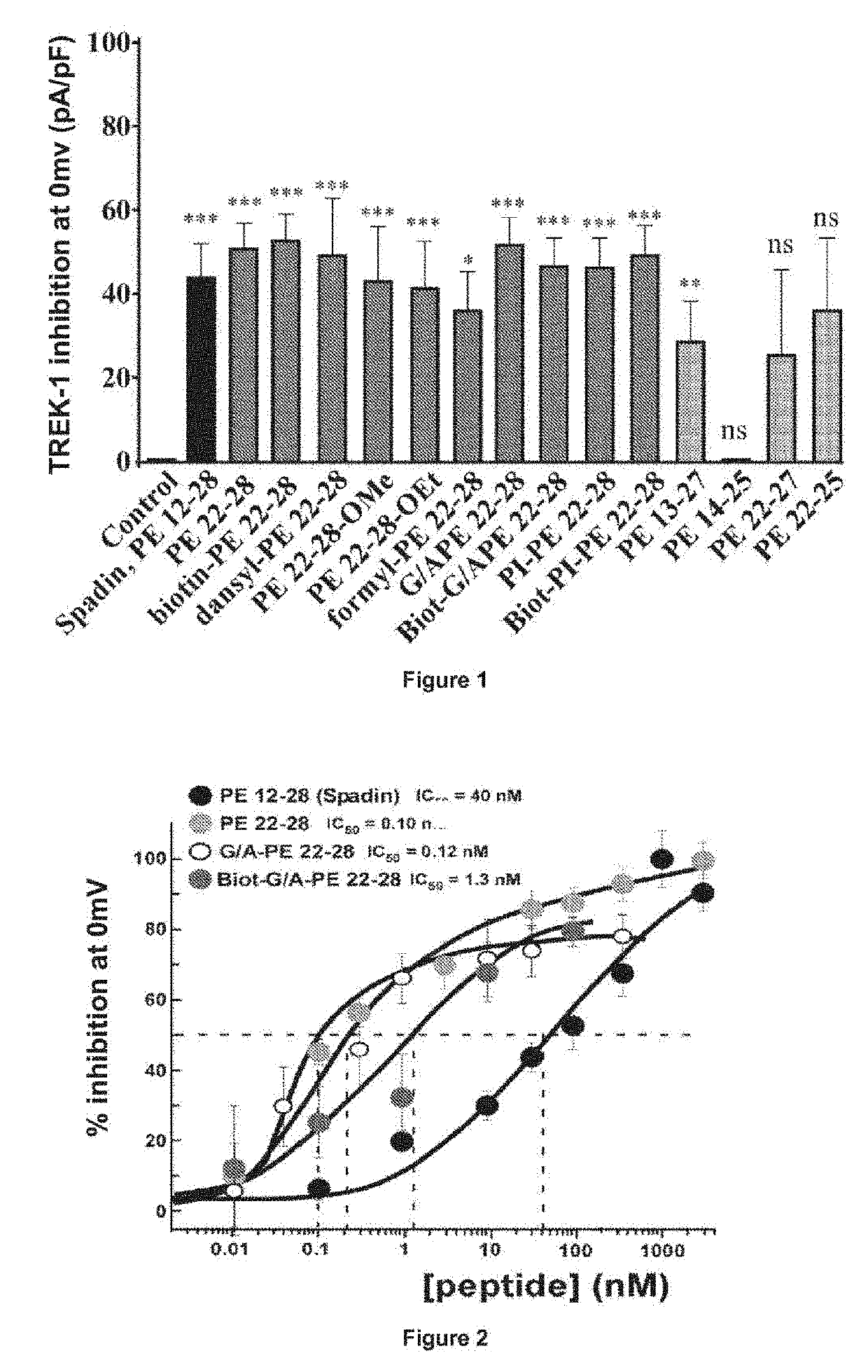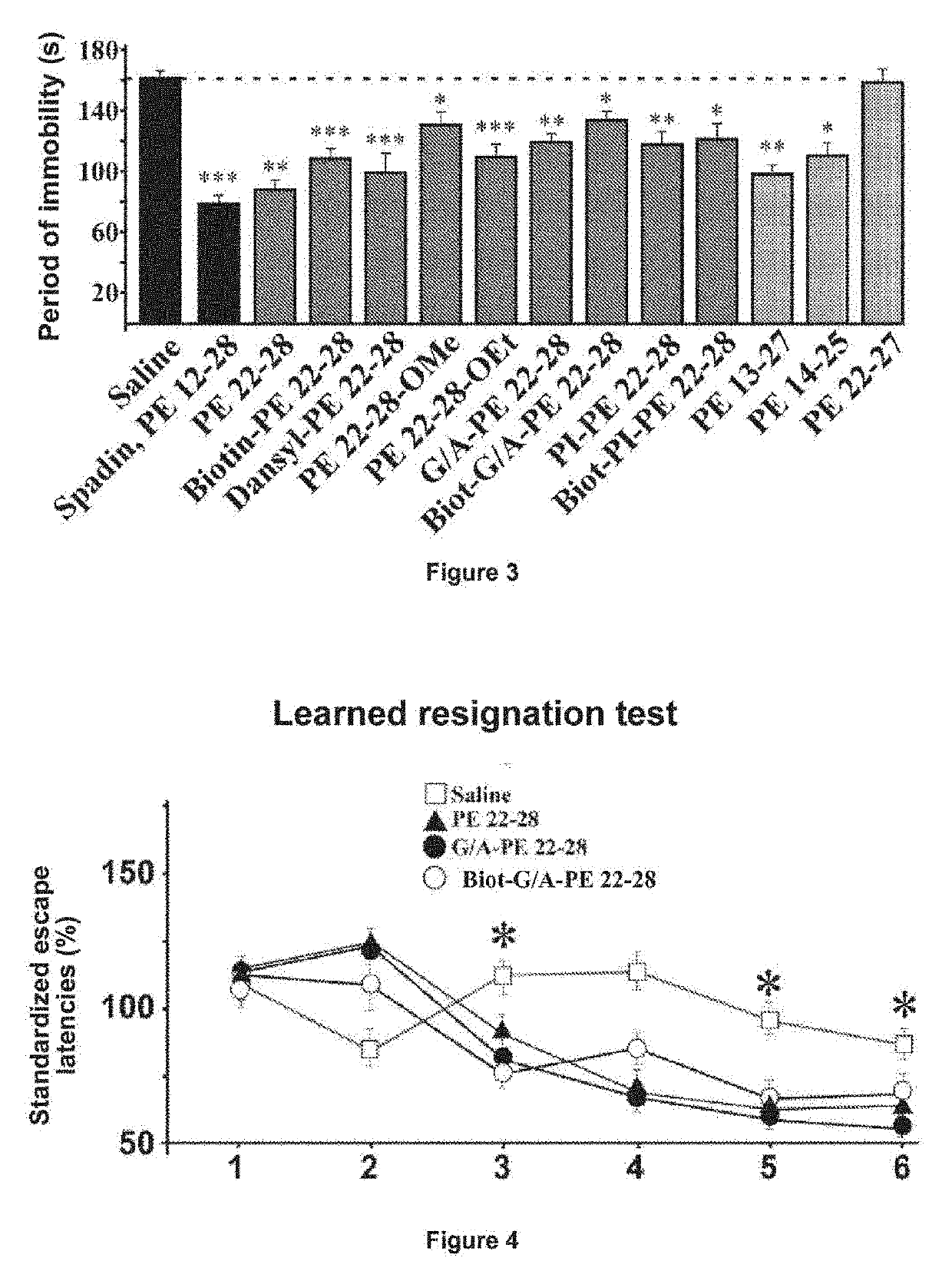Peptides derived from the propeptide ntsr3 and their use in the treatment of depression
a technology of propeptides and peptides, which is applied in the field of short peptides, can solve the problems of depression being a major public health problem, depression is a very common and often debilitating disease, and the economic burden of more than 30 billion euros per year, so as to avoid all undesirable side effects, reduce the time of action, and reduce the effect of long tim
- Summary
- Abstract
- Description
- Claims
- Application Information
AI Technical Summary
Benefits of technology
Problems solved by technology
Method used
Image
Examples
example 1
Spadin Analogs on Trek-1 Canal Activity
[0053]All experiments measuring the effect of spadin analogs and spadin were performed on BTC3 or LNCaP or HEK293 cells stably transfected with the TREK-1 channel, hTREK-1 / HEK293. The hTREK-1 / HEK293 cell line was prepared in the laboratory [21]. These cells also express a reporter gene: E-Green Fluorescent Protein (EGFP) enabling their visualization.
[0054]These cells were seeded at a density of 20,000 cells / dish of 35 mm diameter, 24 to 72 hours before being used.
[0055]The HEK293 cells were cultured in DMEM medium (Gibco) / 10% fetal calf serum (FCS, ICN) / 1% streptomycin+penicillin mixture (Gibco) / 1% glutamax (Gibco) / 0.5 mg / mL of G418 (Sigma) at 37° C. in the presence of 5% CO2.
[0056]The BTC3 cells were cultured in RPMI 1640 medium supplemented with 2.5% FCS, 50 μM beta-mercaptoethanol, 10 mM HEPES, 1 mM sodium pyruvate, 50 μg / ml gentamycin and 1% of a streptomycin+penicillin mixture, at 37° C. in the presence of 5% CO2.
[0057]The LNCaP cells were...
example 2
Tests
Forced Swimming Test (FST)
[0069]A classical behavioral test was developed to determine the antidepressant activity of a substance (Nestier E. J. et al, 2002, Cryan J. and Holmes A., 2005) [22, 23]. The effects of the spadin analogs of the present invention were compared to those of the saline solution in which the spadin analogs of the invention were dissolved and those of the spadin. The mouse strain used was strain C57BI / 6J.
[0070]Saline solution, spadin analogs and spadin were administered to the mice intraperitoneally (IP) at a dose of 100 μg / kg in a bolus of 100 μl.
[0071]The experiment consisted in immersing the mouse for 6 minutes in a container of 15 cm in diameter, 30 cm high containing 11 cm of water at 22° C., 30 minutes after administration of the substance to be tested, and measuring the time of immobility during the last 4 minutes.
[0072]The results of these tests are shown in FIG. 3: FST tests, the values±SEM were statistically compared with the control condition (p...
example 3
Spadine Analogs on Neurogenesis and Synaptogenesis
Study of Neurogenesis by Immunohistochemistry
[0080]BrdU (5-bromo-2′-deoxyuridine) is a synthetic nucleoside analogous to thymidine. It is incorporated during DNA replication during phase S (chromosome duplication during interphase) of the cells in division. Injection of BrdU makes it possible to visualize the cells in division of the tissue to be analyzed by means of immunological labeling. In the present study, the hippocampal neurogenesis of the mice was evaluated after treatment with spadin or the different analogs.
[0081]After the behavioral tests, the mice were injected with BrdU at a final concentration of 120 mg / kg intraperitoneally, according to the modified protocol of Beauquis, J. et al. (Eur J Neurosci 23, 1539-1546, 2007) [25]. Four injections of 300 μl at 10 mg / ml, spaced two hours apart, were performed. 24 hours after the injections, the mice were anesthetized with pentobarbital (100 mg / kg) and then perfused intracardial...
PUM
| Property | Measurement | Unit |
|---|---|---|
| time | aaaaa | aaaaa |
| diameter | aaaaa | aaaaa |
| temperature | aaaaa | aaaaa |
Abstract
Description
Claims
Application Information
 Login to View More
Login to View More - R&D
- Intellectual Property
- Life Sciences
- Materials
- Tech Scout
- Unparalleled Data Quality
- Higher Quality Content
- 60% Fewer Hallucinations
Browse by: Latest US Patents, China's latest patents, Technical Efficacy Thesaurus, Application Domain, Technology Topic, Popular Technical Reports.
© 2025 PatSnap. All rights reserved.Legal|Privacy policy|Modern Slavery Act Transparency Statement|Sitemap|About US| Contact US: help@patsnap.com



